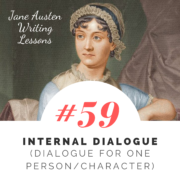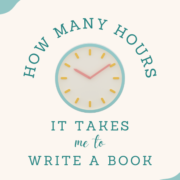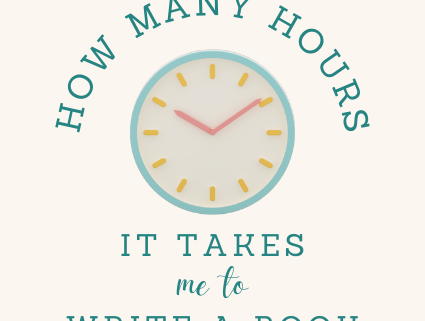Full Sized Blog Element (Big Preview Pic)
#59: Internal Dialogue (Dialogue for One Person/Character)
/0 Comments/in Jane Austen Writing Lessons/by Katherine Cowley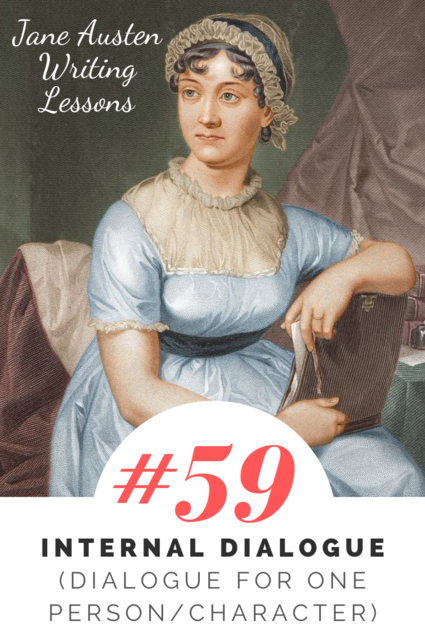
The very roots of the term dialogue imply that it requires more than one person for there to be a dialogue. According to the Online Etymology Dictionary, dialogue comes from the word dia, meaning “across, between,” and legien, meaning “to speak.” In other words, speech is occurring between people.
Yet there are times in fiction when we use dialogue for only one person—when we type something as dialogue, despite there being only one character, or the speech being entirely internal.
In this post I’ll talk about different forms of internal dialogue, including:
- Soliloquys
- Monologues (the cousin of a soliloquy–but not truly internal)
- Other types of dialogue with oneself
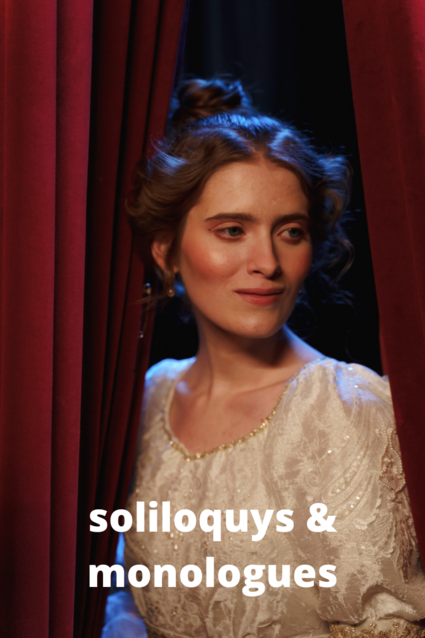
The Theatre Tradition of Speech for One Person
In theater, there are two terms that stand in contrast to dialogue, that represent speech for only one person: soliloquy and monologue.
Soliloquys (One person, with themselves)
A soliloquy is when a character speaks their thoughts aloud. In other words, they are talking to themselves. In a novel, a character can also speak their thoughts aloud—or, if the narrator is providing a close point of view, then a character can talk to themselves entirely in their heads. (In theatre, these thoughts must be spoken aloud, or the audience has no access to them.)
In the novel Persuasion, Jane Austen employs soliloquy when Anne enters her family’s rented house in Bath for the first time:
Anne entered it with a sinking heart, anticipating an imprisonment of many months, and anxiously saying to herself, “Oh! When shall I leave you again!”
Many of the most famous theatre soliloquys are longer passages which reveal much about the characters, their emotions, and their thought processes. Jane Austen incorporates this sort of soliloquy in her novel as well, though most of the time it is not set apart in quotation marks. Instead, she uses an extended passage of free indirect speech (slipping into the character’s thoughts while still using third person) to create longer character soliloquys.
An example of this can be found in the novel Emma, immediately after Emma has found out the truth about the affections of Frank Churchill, Jane Fairfax, and Harriet. This passage would be very easy to rewrite as a spoken Shakespearean soliloquy in a play:
Emma’s eyes were instantly withdrawn; and she sat silently meditating, in a fixed attitude, for a few minutes. A few minutes were sufficient for making her acquainted with her own heart. A mind like hers, once opening to suspicion, made rapid progress. She touched—she admitted—she acknowledged the whole truth. Why was it so much worse that Harriet should be in love with Mr. Knightley, than with Frank Churchill? Why was the evil so dreadfully increased by Harriet’s having some hope of a return? It darted through her, with the speed of an arrow, that Mr. Knightley must marry no one but herself!
Her own conduct, as well as her own heart, was before her in the same few minutes. She saw it all with a clearness which had never blessed her before. How improperly had she been acting by Harriet! How inconsiderate, how indelicate, how irrational, how unfeeling had been her conduct! What blindness, what madness, had led her on! It struck her with dreadful force, and she was ready to give it every bad name in the world. Some portion of respect for herself, however, in spite of all these demerits—some concern for her own appearance, and a strong sense of justice by Harriet—(there would be no need of compassion to the girl who believed herself loved by Mr. Knightley—but justice required that she should not be made unhappy by any coldness now,) gave Emma the resolution to sit and endure farther with calmness, with even apparent kindness.—For her own advantage indeed, it was fit that the utmost extent of Harriet’s hopes should be enquired into; and Harriet had done nothing to forfeit the regard and interest which had been so voluntarily formed and maintained—or to deserve to be slighted by the person, whose counsels had never led her right.
In you are writing a novel or short story in third person, a short soliloquy can be incorporated through either quotation marks around the thought, or by putting the thought in italics. A longer soliloquy will often be through indirect speech. If you are writing in first person, a soliloquy can be marked by quotes or italics, but often is just incorporated naturally into the narrative.
Monologues (One person, with an audience)
A monologue is when a character gives a longer speech aloud to other characters or with a perceived audience. Sometimes this is an entire scene. In Jane Austen’s novels, many characters give monologues intended for an audience to hear (think Mr. Collins).
In many ways, these monologues act like dialogue–there is an audience that is perceived by the character. Yet unlike in dialogue, the character is less likely to be interrupted. As a result, the speech is less of an active conversation with the characters around them.
Monologues take into account persuasive dialogue techniques, and are often meant to stir, change, or impress an audience.
Monologues reflect a character’s internal dialogue, but because they are performative, because they are for in audience, internal thoughts, emotions, and reasoning are filtered through a public, outside intent.

Dialogue for One Person/Dialogue With Oneself
At other times, Jane Austen uses dialogue with only one person, and with no audience, that is not a true soliloquy.
At times, this is because the character is having a sort of conversation with herself. These lines of dialogue can serve a similar role as if someone besides herself had spoken them. Just as in a conversation between two or more people, this internal dialogue with oneself can help the character consider or change her perspective.
In Persuasion, Anne reflects on the fact that her family no longer lives in their ancestral home, Kellynch-hall, and that it is now occupied by the Crofts:
She could not but in conscience feel that they were gone who deserved not to stay, and that Kellynch-hall had passed into better hands than its owners….
In such moments Anne had no power of saying to herself, “These rooms ought to belong only to us. Oh, how fallen in their destination! How unworthily occupied! An ancient family to be so driven away! Strangers filling their place!” No, except when she thought of her mother, and remembered where she had been used to sit and preside, she had no sigh of that description to heave.
In this passage, Anne does not say this dialogue to herself—or at least not unless she is thinking of her mother. But by considering that she could say this to herself, she is presenting a counterargument to her actual views, a perspective that is she is consciously setting aside and not incorporating into her being.
Austen uses many other innovative approaches to internal dialogue, but we are just going to consider one more. In some passages, dialogue that was spoken is then internally repeated as the character attempts to process it or deal with the words.
In Persuasion, after the first time in which Anne and Captain Wentworth meet in the present day, Mary informs Anne what Captain Wentworth thought of her:
“Captain Wentworth…said, ‘You were so altered he should not have known you again.’”
This leads to a flurry of emotions for Anne. She ends up repeating variations of this line of dialogue twice in her mind:
“Altered beyond his knowledge!” Anne fully submitted, in silent, deep mortification. Doubtless it was so; and she could take no revenge, for he was not altered, or not for the worse. She had already acknowledge it to herself, and she could not think differently, let him think of her as he would. No; the years which had destroyed her youth and bloom had only given him a more glowing, manly, open look, in no respect lessening his personal advantages. She had seen the same Frederick Wentworth.
“So altered he should not have known her again!” These were words which could not but dwell with her. Yet she soon began to rejoice that she had heard them. They were of sobering tendency; they allayed agitation; they composed, and consequently must make her happier.
While dialogue traditionally requires at least two people, soliloquys and other types of internal dialogue can be used to great effect, especially as a character looks deeply at themselves, reflects on their life, or decides to move in a new direction.

Exercise 1: Write a soliloquy for one of your characters at a key point in the story, as if they were performing this soliloquy on a stage.
What does this soliloquy teach you about your character? Should parts of it be incorporated into your story, either through internal dialogue or free indirect speech?
Exercise 2: The next time you read a novel, pay close attention to the dialogue. How often does the writer use two people in a scene of dialogue? Three people? Four people? A larger group? Are there any monologues? Are there any moments where the writer uses soliloquy or other sorts of internal dialogue? What is the effect of each different type of dialogue on the character and on the plot?
Exercise 3: Write a short scene which takes an innovative approach to internal dialogue or dialogue with only one character. A few ideas for the type of internal dialogue that you could use:
- A conversation (or argument) with oneself
- Theoretical dialogue that did not or could not occur
- Imagining what another character might say
- Repeated line of dialogue, with or without variation (either the character’s own dialogue, or something someone else said to them or about them)
- Recollection of a series of different things that have been said to the character (by an individual or a group of people)
How Many Hours It Takes Me to Write a Book
/2 Comments/in Secret Life of Miss Mary Bennet, Updates, Writing/by Katherine Cowley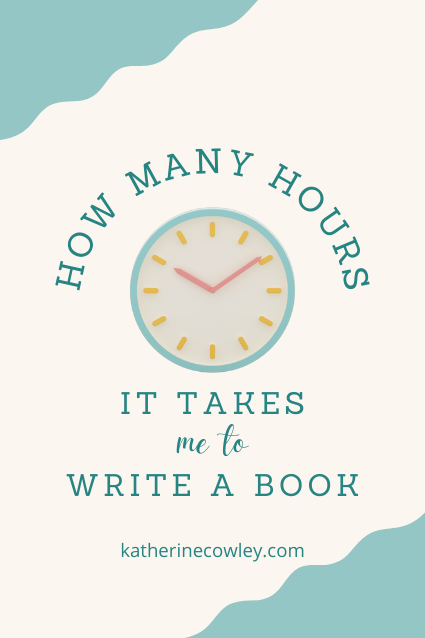
On one of my blog posts recapping a year in writing, a reader recently asked how long it takes me to write a novel, and how this time breaks down between drafting and revision.
Because I track my writing time, I can answer both questions rather easily.
Question 1: Total Number of Hours to Write A Novel
For the past three novels I have written, it has taken me between 400 and 650 hours to write and revise the book.
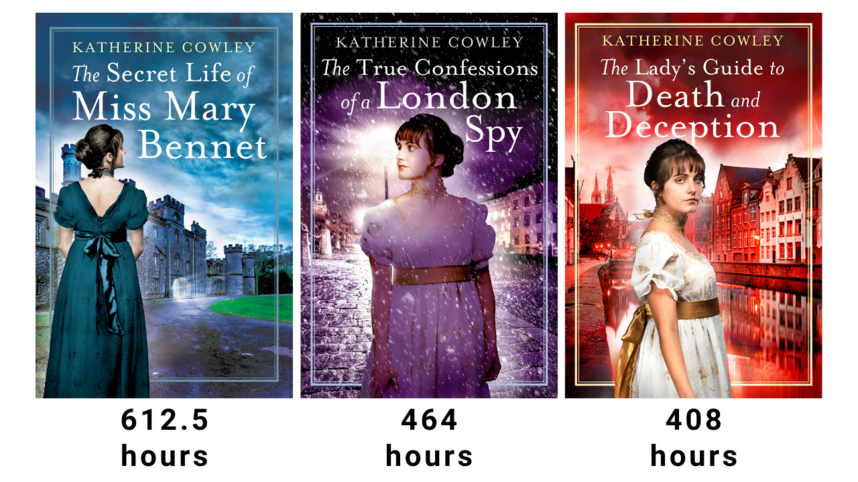
Question 2: The Time Breakdown (How these hours were spent)
This question gets a little more complicated, because I wrote the first drafts for The Secret Life of Miss Mary Bennet and The True Confessions of a London Spy at the same time. However, I went back through my time tracking app, did some number crunching, and broke things out.
Disclaimer: I came up with the premise for the series in 2013, and I did some initial research, and then spent years thinking about the characters and their motivations, daydreaming about scenes, planning emotional arcs, etc. None of this time is included in the following charts, which only include time spent after mid-2017.
Disclaimer 2: rounding occurred at various points when I exported from my time tracking app and then added numbers in Excel. If the numbers are off by an hour or two, then it’s because you’re not seeing all the rounding.
Time Spent Writing and Revising The Secret Life of Miss Mary Bennet
- Research
- Outlining
- Draft 1
- Draft 2
- Draft 3
- Newspaper Research
- Draft 4
- Draft 5
- Draft 6 (with agent)
- Draft 7 (with agent)
- Revisions with Publisher
- Other Tasks
- 76 hours
- 34 hours
- 113 hours
- 88.5 hours
- 108 hours
- 18 hours
- 6 hours
- 14.5 hours
- 77.5 hours
- 17 hours
- 33 hours
- 27 hours
Note: the first draft, which took me 113 hours, was spread out (along with research and outlining) over a period of 11 months. This was a novel that took time to simmer and develop!
What each draft focused on
First draft: The first draft is for me to get the story down. I do revise some as I go, but I also leave plenty of comments for myself for things to fix later. Sometimes I will skip scenes or chapters that I know I will need to add in a future draft, and I am often missing names for key characters (I’ll have lots of _________ to show that I need to add it later). I never show full first drafts to anyone, but I did show bits and pieces to my monthly writing group to get some initial feedback.
Second draft: This draft is the get-it-ready-to-look-at by other people draft. I fill in whatever gaps are left from the first draft, do lots of big picture changes (plot, structure, emotion, relationships, and character), and constantly tweak things at a language and sentence level.
Then I sent the book to my first round of critique partners.
Third draft: Some people break out different types of edits (structural, character, language) into different drafts. I kind of do them all at once. First I created a very large chart on my wall which helped me figure out how to fix bigger picture plot and character problems, and then I dove into changes. For me, a draft sometimes consists of multiple passes–during a single revision, I may go through chapters anywhere from 1 to 4 times, and sometimes I’ll be revising a later chapter and realize I need to go back and change something in a previous chapter that I thought was finished. I decide a draft is finished when I’ve taken care of all the things that seem most crucial–that are really bothering me. I won’t necessarily address every single thing my critique partners have suggested; some I do save for future revisions, and others I set aside and don’t incorporate.
I then added newspaper headings and sent the book to a new set of critique partners. (I like to use people who haven’t yet read the novel and can offer a fresh perspective.) In this case, draft four did not take very long, and then I started querying agents. Then I did another draft and queried more. Then I got my agent–and I wrote a post that talks about the revisions that I did with my agent.
Once the book was acquired by Tule, we did a content edit, another more minor content edit, an edit to make the book shorter, and then copyedits and proofreads.
Time Spent Writing and Revising The True Confessions of a London Spy
- Research
- Outlining
- Draft 1
- Draft 2
- Draft 3
- Newspaper Research
- Draft 4
- Draft 5
- Revisions with Publisher
- Other Tasks
- 67 hours
- 9 hours
- 48 hours
- 149.5 hours
- 11.5 hours
- 19 hours
- 71 hours
- 48 hours
- 35.5 hours
- 5 hours
You will notice that I spent a lot less time on this first draft. However, I paid for it during the second draft, which still holds its winning place as the hardest draft I have ever written in my life.
The drafting process was similar to the first book, however, because the second draft was such a major revision, in this case I did a quick third draft to clean things up before sending to critique partners.
Time Spent Writing and Revising The Lady’s Guide to Death and Deception
- Research
- Outlining
- Draft 1
- Draft 2
- Draft 3
- Newspaper Research
- Draft 4
- Revisions with Publisher
- Other Tasks
- 24 hours
- 14 hours
- 147 hours
- 64 hours
- 93 hours
- 16 hours
- 26.5 hours
- 20 hours
- 3 hours
I wrote the first draft of The Lady’s Guide to Death and Deception over a period of six months. And that was hard–I don’t think I could easily write a first draft in less than that, because I only have so many high-level creative energy on any given day or week, and there are parts of the creative process that just can’t be rushed.
Why Some Books Take More or Less Time
If I’m going to undergo some self-analysis and reflection (why not? I made charts!) then I would say that the first book in the series took the longest in part because it was the first book. I was still figuring out characters, relationships, and arcs. And I was able to apply a lot of what I figured out about the characters–as well as a lot of the research–to books 2 and 3.
My agent and my editor also taught me things about writing, and mysteries specifically, which I was able to apply in the process of writing both books 2 and 3. This truly did cut out a couple of drafts.
Also, book 3 in the series was the only book I have written in which I managed to include both the plot AND all the major sub-plots in the first draft. (In the first draft of both The Secret Life of Miss Mary Bennet and The True Confessions of a London Spy, I had most of the subplots, but the main plot was shaky.)
How Long It Will Take Me to Write Future Books
Prior to the Mary Bennet series, I wrote several (unpublished) novels, but I wasn’t as exact about keeping track of time. Based on the records I have, one novel probably took me at least 700 hours. A novella I wrote (“Tatterhood and the Prince’s Hand“) took about 144 hours.
I truly expect that all my future novels will take me at least 400 hours, and if it’s the first book in a series, it could very likely be in the 600 hour range. I’m currently working on a new secret novel, and I’ve already spent 33 hours on brainstorming and research. I could easily have another 60 to 100 hours of research and outlining before I’m ready to start writing the first draft.
I have a number of writing friends who write much more quickly than I do, but I also have plenty of writing friends who take comparable or longer amounts of time to write and revise a novel. There’s no one right way to do it, and either can produce amazing work, as long as it works well with your writing process and your other life commitments.

